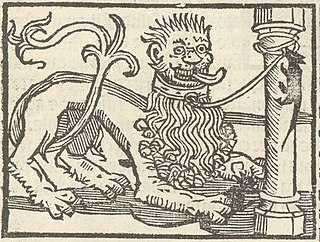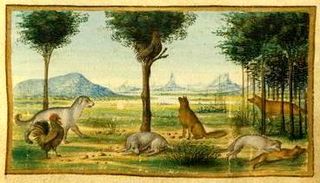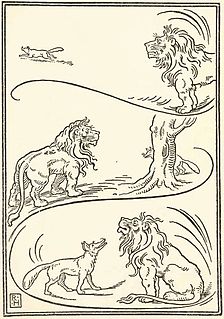
Fable is a literary genre: a succinct fictional story, in prose or verse, that features animals, legendary creatures, plants, inanimate objects, or forces of nature that are anthropomorphized, and that illustrates or leads to a particular moral lesson, which may at the end be added explicitly as a concise maxim or saying.

Ivan Andreyevich Krylov is Russia's best-known fabulist and probably the most epigrammatic of all Russian authors. Formerly a dramatist and journalist, he only discovered his true genre at the age of 40. While many of his earlier fables were loosely based on Aesop's and La Fontaine's, later fables were original work, often with a satirical bent.

Gaius Julius Phaedrus was a 1st-century CE Roman fabulist and the first versifier of a collection of Aesop's fables into Latin. Few facts are known about him for certain and there was little mention of his work during late antiquity. It was not until the discovery of a few imperfect manuscripts during and following the Renaissance that his importance emerged, both as an author and in the transmission of the fables.

Aesop's Fables, or the Aesopica, is a collection of fables credited to Aesop, a slave and storyteller believed to have lived in ancient Greece between 620 and 564 BCE. Of diverse origins, the stories associated with his name have descended to modern times through a number of sources and continue to be reinterpreted in different verbal registers and in popular as well as artistic media.
A fable is a story intended to illustrate a moral.

The Fox and the Grapes is one of Aesop's fables, numbered 15 in the Perry Index. The narration is concise and subsequent retellings have often been equally so. The story concerns a fox that tries to eat grapes from a vine but cannot reach them. Rather than admit defeat, he states they are undesirable. The expression "sour grapes" originated from this fable.

The Fox and the Crow are a pair of anthropomorphic cartoon characters created by Frank Tashlin for the Screen Gems studio.

The Crow and the Pitcher is one of Aesop's Fables, numbered 390 in the Perry Index. It relates ancient observation of corvid behaviour that recent scientific studies have confirmed is goal-directed and indicative of causal knowledge rather than simply being due to instrumental conditioning.

The Lion and the Mouse is one of Aesop's Fables, numbered 150 in the Perry Index. There are also Eastern variants of the story, all of which demonstrate mutual dependence regardless of size or status. In the Renaissance the fable was provided with a sequel condemning social ambition.
Chanticleer and the Fox is a fable that dates from the Middle Ages. Though it can be compared to Aesop's fable of The Fox and the Crow, it is of more recent origin. The story became well known in Europe because of its connection with several popular literary works and was eventually recorded in collections of Aesop's Fables from the time of Heinrich Steinhowel and William Caxton onwards. It is numbered 562 in the Perry Index.

The Mischievous Dog is one of Aesop's Fables, of which there is a Greek version by Babrius and a Latin version by Avianus. It is numbered 332 in the Perry Index. The story concerns a dog that bites the legs of others. Its master therefore ties a bell around its neck to warn people. The dog, thinking the bell is a reward, shows it off in the streets until an older dog reminds him that the bell is not a reward but a sign of disgrace. Victorian editors of the fables supplied the moral that 'notoriety is often mistaken for fame'.
Foxy Fables is an animated television series produced by the leading Israeli animator Rony Oren. All the characters were made from moulded plasticine modelling clay on metal armatures, and filmed with stop motion clay animation.

The Fox and the Crow is one of Aesop's Fables, numbered 124 in the Perry Index. There are early Latin and Greek versions and the fable may even have been portrayed on an ancient Greek vase. The story is used as a warning against listening to flattery.

Aesop was a Greek fabulist and storyteller credited with a number of fables now collectively known as Aesop's Fables. Although his existence remains unclear and no writings by him survive, numerous tales credited to him were gathered across the centuries and in many languages in a storytelling tradition that continues to this day. Many of the tales are characterized by animals and inanimate objects that speak, solve problems, and generally have human characteristics.
The Bear and the Gardener is a fable of eastern origin that warns against making foolish friendships. There are several variant versions, both literary and oral, across the world and its folk elements are classed as Aarne-Thompson-Uther type 1586. The La Fontaine version has been taken as demonstrating various philosophical lessons.
The Perry Index is a widely used index of "Aesop's Fables" or "Aesopica", the fables credited to Aesop, the storyteller who lived in ancient Greece between 620 and 560 BC. Modern scholarship takes the view that Aesop probably did not compose all of the fables attributed to him; indeed, a few are known to have first been used before Aesop lived, while the first record we have of many others is from well over a millennium after his time. Traditionally, Aesop's fables were arranged alphabetically, which is not helpful to the reader. B. E. Perry listed them by language, chronologically, by source, and then alphabetically; the Spanish scholar Francisco Rodríguez Adrados created a similar system. This system also does not help the casual reader, but is the best for scholarly purposes.

The Cock, the Dog and the Fox is one of Aesop's Fables and appears as number 252 in the Perry Index. Although it has similarities with other fables where a predator flatters a bird, such as The Fox and the Crow and Chanticleer and the Fox, in this one the cock is the victor rather than victim. There are also Eastern variants of this story.

The Fox and the Lion is one of Aesop's Fables and represents a comedy of manners. It is number 10 in the Perry Index.
The Bird in Borrowed Feathers is a fable of Classical Greek origin usually ascribed to Aesop. It has existed in numerous different versions between that time and the Middle Ages, going by various titles and generally involving members of the corvid family. The lesson to be learned from it has also varied, depending on the context in which it was told. Several idioms derive from the fable.

The Wolf and the Shepherds is ascribed to Aesop’s Fables and is numbered 453 in the Perry Index. Although related very briefly in the oldest source, some later authors have drawn it out at great length and moralised that perceptions differ according to circumstances.













